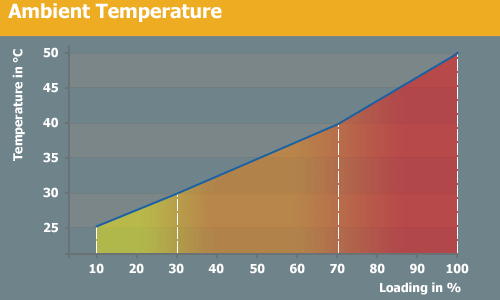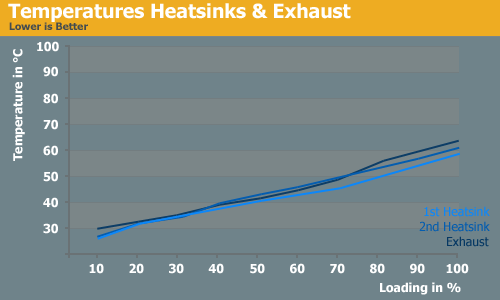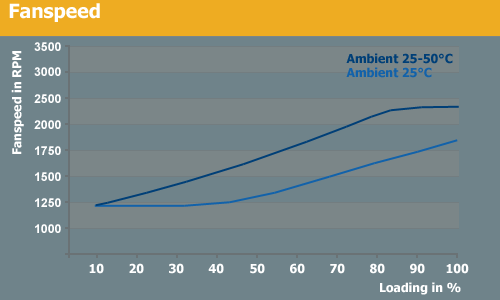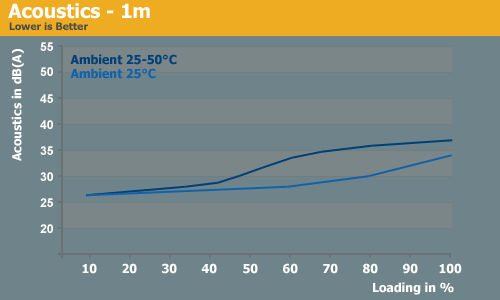Silver Power Blue Lightning 600W
by Christoph Katzer on August 27, 2007 6:00 AM EST- Posted in
- Cases/Cooling/PSUs
Temperatures



Our testing confirms our initial impression of the heatsinks. They dissipate heat quite well and manage to cool all of the components attached to them. Exhaust temperatures of only 50°C at 26° room temperature, even at maximum load, mean that users will have a relatively cool system. With a 50°C test environment, exhaust temperatures rise 15°C up to 65°C, while the heatsinks are only 10°C warmer than the ambient temperatures. These are fairly good results, but in a stress test environment temperatures are rising quite rapidly and we definitely would be cautious about using this power of supply in such an environment for an extended period of time. At normal room temperatures, the results are much better.
Fan Speed and Acoustics


In our stress testing "heat chamber", fan speed is constantly rising up to the maximum speed of around 2400 RPM as the load and temperatures increase. At room temperatures, the fan holds a steady 1250 RPM up until about a 45% load. While the fan speed is definitely increasing, it's a bit unusual - and actually impressive - that the noise levels continue to stay relatively low, reaching a maximum of 37 dB at full load. Subjectively, the noise levels also agree with what we see on the charts: at maximum load the power supply isn't much louder it than at minimum load. Unfortunately, you can still hear the fan regardless of load, but once placed within a typical computer case the result should be a good, reasonably quiet system.



Our testing confirms our initial impression of the heatsinks. They dissipate heat quite well and manage to cool all of the components attached to them. Exhaust temperatures of only 50°C at 26° room temperature, even at maximum load, mean that users will have a relatively cool system. With a 50°C test environment, exhaust temperatures rise 15°C up to 65°C, while the heatsinks are only 10°C warmer than the ambient temperatures. These are fairly good results, but in a stress test environment temperatures are rising quite rapidly and we definitely would be cautious about using this power of supply in such an environment for an extended period of time. At normal room temperatures, the results are much better.
Fan Speed and Acoustics


In our stress testing "heat chamber", fan speed is constantly rising up to the maximum speed of around 2400 RPM as the load and temperatures increase. At room temperatures, the fan holds a steady 1250 RPM up until about a 45% load. While the fan speed is definitely increasing, it's a bit unusual - and actually impressive - that the noise levels continue to stay relatively low, reaching a maximum of 37 dB at full load. Subjectively, the noise levels also agree with what we see on the charts: at maximum load the power supply isn't much louder it than at minimum load. Unfortunately, you can still hear the fan regardless of load, but once placed within a typical computer case the result should be a good, reasonably quiet system.










33 Comments
View All Comments
Samus - Monday, August 27, 2007 - link
It appears that a log of people on newegg have this PSU fail after a few months. Now before we get into newegg consumer feedback 'reliability' :) there are a few people who've had these fail, not just one or two.I'm ganna give it a shot anyway. Should work well with my DFI Infinity 975 board, being EPS12v and all.
Slaimus - Wednesday, August 29, 2007 - link
Knowing it is an Apex-built power supply took most of the wind out of its sails. Apex, also known as L&C and Deer, has made some of the most unreliable power supplies ever.This seems to be one of their better efforts, but reliability will always be a concern with this company.
mindless1 - Thursday, August 30, 2007 - link
SMPS tech is reasonably mature beyond present tweaking a bit for higher efficiency, more 12V current, and these without cost rising out of control.Point being, Apex (actually better known as Foxconn or Hon Hai) can easily build quality PSU, it is not inability it is the choice of product placement and construction cost that results in some of the junk we've all seen.
As for reliability, there is a problem as always that you hear of someone with a failed PSU but no autopsy most of the time. No disrespect meant to reviewers, but over the years I can't could how many times a product seemed good at first glance, and second glance (a review period), but later a fault compromised the lifespan. A review of one unit can't take forever, it is going to be inherantly limited in scope, but still must be seen as a way to disqualify products more than qualify them for long term use.